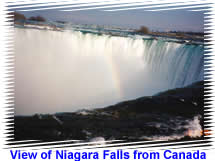
Dimdima
Online Children's Magazine from India

Dimdima
Online Children's Magazine from India

The 4th of July is right around the corner, and Independence Day celebrations are being planned all over the US of A. As my friends and neighbours get ready to participate in the traditional 4th of July parades, barbeques and fire-work displays, I am packing my bags to head out to upstate New York. This year, I will be spending my long weekend vacationing by the Niagara Falls across the US-Canadian border. I cannot think of a more awesome locale to view the annual display of colourful fireworks!
Geologically speaking, the Niagara River is a relatively young river; it is only about 12,000 years old. This “river” is not really a river at all. It is, in fact, a strait, and it derives its modern name from the ancient Iroquois Indian word, “Onguiaahra,” meaning “the straits.” Straits are narrow bodies of water that connect larger bodies; Niagara connects two of North America’s “Great Lakes,” Lake Erie and Lake Ontario. Together, the Great Lakes (Superior, Michigan, Huron, Erie and Ontario) contain one-fifth of the world’s supply of fresh water. As it runs through the Niagara Escarpment, which is an ancient geological formation, made up of many layers of sedimentary rocks, the Niagara River diverges to form two breathtaking waterfalls which mark the international border between the United States and Canada. The American Falls is located on the US side of the border, and the Horseshoe Falls is located on the Canadian side. The American Falls are 180 feet high and 1,100 feet long. The Horseshoe Falls (so named because it resembles a horseshoe in shape) are 170 feet high. To the right of the American Falls is a smaller body of water, popularly known as The Bridal Veil, because it resembles a bride’s white netted veil.
The Niagara Falls has enchanted human beings since time immemorial. Although nothing is known about the earliest settlers of this region, Native Americans including the Iroquois had thriving settlements here. Louis Hennepin, a Franciscan monk is the first known European explorer to document these falls. He chanced upon them during his travels somewhere around 1678. As word spread several Europeans sought to make this fertile basin their home. Soon, people began to find new ways to explore the falls. A new brood of people, known as the daredevils, sought to conquer the falls by going over the Canadian Horseshoe barrels. Annie Edson Taylor led the way in 1901, when she chose to brave the falls by “taking the plunge” while nestled inside a wooden barrel she designed herself. Several others followed suit in the coming years and most have lived to tell their amazing tales!
Today, these breathtaking waterfalls which are second only to the Victoria Falls in the African heartland host approximately 12 million tourists every summer. Every April, after the ice melts away, tourists can journey into the heart of the American Falls aboard the Maid of the Mist, a tourist ferry boat. Many tourists also visit the Cave of the Winds, a slippery cavern located behind the Bridal Veil Falls. In order to control the ill effects of erosion, and to preserve the beauty of the falls for future generations, the governments of America and Canada have mutually decided to regulate the water levels of the waterfalls. The two countries also draw upon the water power of the Niagara Falls to generate hydro electricity.
It’s time for me to get ready for my long flight to Buffalo, New York, so let me bid adieu. I will be back in a fortnight with yet another interesting tale….
Dimdima is the Sanskrit word for ‘drumbeat’. In olden days, victory in battle was heralded by the beat of drums or any important news to be conveyed to the people used to be accompanied with drumbeats.
Bharatiya Vidya Bhavan
K. M Munshi Marg,
Chowpatty, Mumbai - 400 007
email : editor@dimdima.com
Bharatiya Vidya Bhavan
505, Sane Guruji Marg,
Tardeo, Mumbai - 400 034
email : promo@dimdima.com
Dimdima.com, the Children's Website of Bharatiya Vidya Bhavan launched in 2000 and came out with a Printed version of Dimdima Magazine in 2004. At present the Printed Version have more than 35,000 subscribers from India and Abroad.